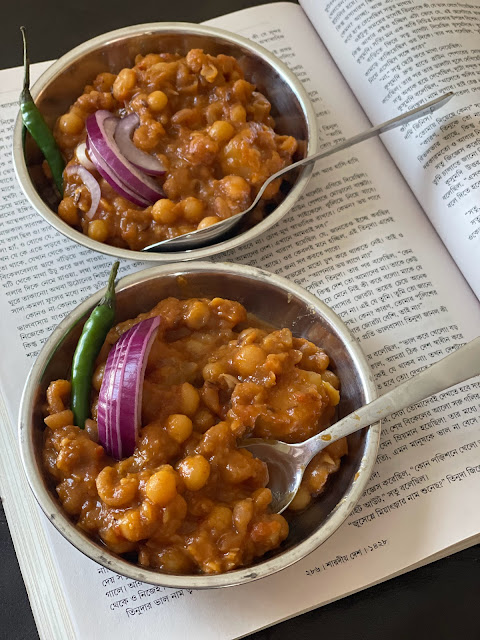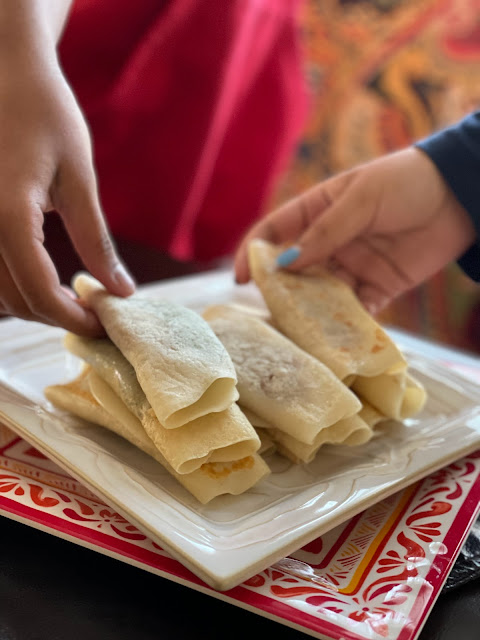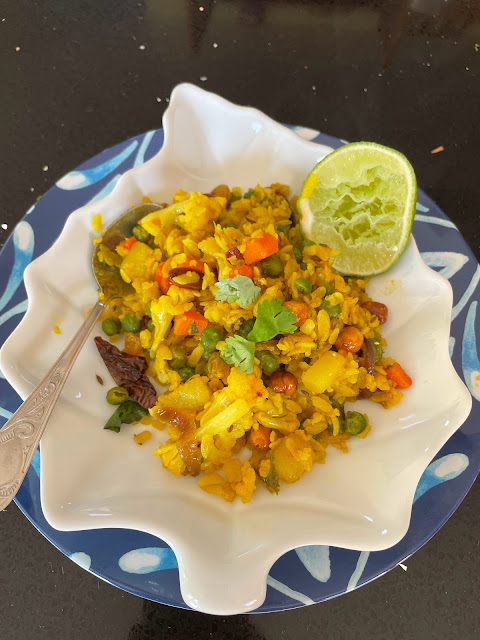Let me jog your memory and remind you of the
A-Z of Bengali Cuisine that I have been half-heartedly attempting since last year. I mean my heart is fully into it but I keep falling back in chronicling the recipes.
Anyway,let me remind you that around November last year, we were stuck at the
Letter "F". Not the word, the letter. The reader's choice popular awards demanded "
F for Fuchka", "
F for Fish Orly" and "
F for Fish Fry".
However what was stuck in the grooves of my brain was steeped in memory, nostalgia and zero real life experience. F
for "Fuluri".
A few yards away from my maternal grandmother's home in northern parts of Kolkata, right behind a small temple that was built upon faith and an old banyan tree, there was a
narrow lane. This narrow lane was one of the many, many narrow lanes that crisscrossed that part of the city.Those days cars and buses were few and they for the most part stuck to the main roads. Bicycles, rickshaws and mostly people on foot plied the narrow
gallis. Even then the by-lanes were a quiet, peaceful haven where you could chalk the time of the day by observing the thoroughfare.

Early morning as the eastern sky turned pink, you could hear the trill of the bicycle bells of the doodhwallah, the thwack of the newspaper guy who brought news on his bicycle and the faint All India Radio signature tune of "Vande Mataram" from the houses along the lane who stirred and woke up from deep slumber. Little later the lane would resound with high pitched voices of kids in school uniform, the tiny ones with sleep in their eyes and their small fingers wrapped around their mother's, the older ones huddled close with their friends, walking towards the school bus stop. Almost the same time as the school crowd there would be the "bajaar goers", middle aged men, sometimes women, purposefully striding towards the morning market to get the best fish for the day. This was when the lane would get really busy and you would know the small hand of clock was somewhere around 8 and 9 in the morning.
By the time the sun had risen further and the shadows stretched long and thin from one end of the lane to the other, office goers with their briefcase, three tiered tiffin carrier and a small box of paan, marched along the lane, to wait for their crowded bus at the corner where the narrow lane met the main road.
Soon after, with the sun high up in the sky, the lane would turn hushed, sleepy, interrupted only by sounds of a pressure cooker whistle or the hiss and sputter of mustard oil. Elderly men would sit out on the porch and maids with slim waist bang doors as they rushed from one home to another.
Sometime around 5 in the evening, in this very ordinary lane, a
small shop would open its shutters. The shop was nearer to the main road and closer to the temple. A very strategic location.
And in this shop, there would be an old woman, sitting behind a huge
black kadhai that rested on a
unoon, a coal fire stove. Great amount of oil sizzled in this Kadhai. The old woman swirled her bony wrists and poured dollops of chickpea and various other batter into the hot oil. The oil bubbled and sputtered angrily, magically turning the batter into golden balls, which she then took out with a slotted spoon, and served to her customers in paper cones made of day old newspaper. Her small store front would be so crowded with cries of "
Chaar te Chingrir Chop", "
Duto Beguni", "
Dash ta Fuluri", that you had to stand sideways and push with your shoulder to get an entry. By mid evening pools of yellow light gathered under the street lamps and the lane was redolent with heavenly smell of deep fried food. This was "
Buri'r telebhajar dokaan"(the old woman's fritter shop) from where my uncles got beguni, aloor chop and fuluri, wrapped in newspaper, on rare evenings.
And this is the only place where I ever had "Fuluri". Rest were all Pakori.
Now, I always
assumed "Fuluri" was same as "Pakora or Pakori". Whenever chickpea batter fritters were made at home, my Mother used the term "Pakora" and never "fuluri", but I though they both were basically the same. The husband-man who has stronger memories of Fuluri claimed that
"Fuluri" has to be bigger, rounder and more air filled than Pakori. It
doesn't have vegetable or onions which we tend to put in a pakori batter. He also insisted that in addition to besan(chickpea flour), "Fuluri" has to have some dal paste in the batter.
After all even "The word pakoṛā is derived from Sanskrit पक्ववट pakvavaṭa a compound of pakva 'cooked' and vaṭa 'a small lump' or its derivative vaṭaka 'a round cake made of pulse fried in ghee" -- source Wiki.
So what was after all Fuluri?
To verify the husband-man's claim, I scoured the internet for "Fuluri" and got pages and pages of
Trinidad Pholouries. In Trinidad homes, pholourie is fried balls of a thick batter made from flour, yellow split-pea flour, turmeric and cumin (and other seasonings like garlic as well, depending on the cook).Clearly the Bangali Fuluri and Trinidad Phulourie were first cousins. It was more natural that it emigrated to Trinidad from Bihar where such fritters go by the name of "phulourie".
Next I turned to
Progyasundari Devi's book, treasures gifted by my friend A. In there she has recipes of Fuluri which is made of only Besan just like pakori and she calls them "
Besan er Fuluri". She also has recipes of
Oriya Fuluri which uses dal paste in the batter.
To come to a conclusion, I then asked my trusted
Encyclopedia Britannica of food, Pritha Sen. We debated a bit over whether dal paste should or should not go in a fuluri batter until she threw open the debate on her Facebook timeline. Somnath, another ardent food enthusiast got to work.This is what happened after that.
Straight from Pritha Di's Facebook post:
"Somnath Roychoudhury took matters into his own hands and went on a street food jaunt, talking to three Phuluri makers. Somnath said it was the fluffiness that led to the name --
Phuley otha besan bhaja (Fluffed up fried besan). He said that he doubted if any cook book writer ever mastered real streetfood. He said that there is a variety of besan you get in the market for commercial use. It's not as fine as the branded besan and that besan is a must for a good fuluri which tastes best if you eat it super hot. Somnath went across to Tyangra and two places in Behala, acorss the city and has this to say:
"
According to the vendors I spoke to, there are two kinds of Phuluris -- one is hard and crusty with a soft fluffy inside, which is probably made from grainy and coarse besan mixed with different flavourings and fried the size of Rajbhog. The second has a softer outer layer with super fluffy inside made from fine powdered besan. No no daal paste business. Dalpaste is used in daal pokora or mixed with besan to make Daal bora."
His findings corroborated what some others had been saying. That a Phuluri is besan batter, beaten well with chopped green chillies and chilli powder and salt and bicarbonate of soda and deep fried into round fluffy balls and served with spiced salt sprinkled over it. To further prove his point he has pictures and a video of the Phuluri maker whipping the batter.
So Sandeepa, the conclusion was that when affluent Bengali homes recreated the Phuluri in their own kitchens, they did so with the ingredients they were used to making boras from, not having had the privilege to talk to the actual street food makers about how it was done. So
a Phuluri is plain batter fried into fluffy balls and never has any vegetable in it."
Isn't it interesting how a simple thing like Fuluri can set you on a long trail ?
I decided to
merge the recipe of Oriya Fuluri and the Besan Fuluri to make my own. We liked the result. The inside was soft fluffy and the outside was more crunchy. Mine were almost like a pakori and didn't really look like round balls of Trinidad Pholourie. As Somnath said, you need some amount of street food expertise to make the perfect round balls.
*
You can skip the chana dal paste and use only chickpea flour or besan to make your Fuluri.
Fuluri or Phuluri
Soak
1/2 Cup of Split Pea/Chana Dal for an hour.
With little water, grind this dal to a paste.
Now in a wide mouthed bowl
pour the dal paste.
To it add
1/2 cp of Besan/Chickpea Flour
Salt to taste
1/2 tsp of baking soda
2 green chilli finely chopped
Adding little water, whip up the batter to make a thick smooth paste. Don't pour water all at once. Add water gradually until you get a smooth batter without any lumps.
Now heat enough oil for deep frying. Take
a tsp of hot oil and mix it with the batter.
Now test if the oil is ready for frying. Put a drop of the batter in the oil. If it sinks, oil is not ready yet. If the drop of batter bubbles and floats back then oil is just right.
Drop in
spoonfuls of batter in the hot oil and watch it swell and turn golden. With a slotted spoon gently move them around until the ball is golden brown.
Take the crispy golden brown balls out and let it drain on a paper towel. Sprinkle some rock salt/pink salt and serve.
Great with a cup of hot chai.
If you like what you are reading, get Bong Mom's Cookbook in your mailbox



















































